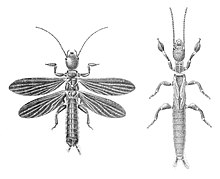Webspinner
| Embioptera Temporal range: 199–0 Ma Jurassic – Recent |
|
|---|---|
 |
|
| Scientific classification | |
| Kingdom: | Animalia |
| Phylum: | Arthropoda |
| Class: | Insecta |
| Infraclass: | Neoptera |
| Order: |
Embioptera Lameere, 1900 |
| Families | |
|
There are 2 suborders and 10 families: |
|
There are 2 suborders and 10 families:
The order Embioptera, commonly known as webspinners, are a small group of mostly tropical and subtropical insects, classified under the subclass Pterygota. The order has also been referred to as Embiodea or Embiidina. The name Embioptera ("lively wings") comes from Greek, εμβιος, embios meaning "lively" and πτερον, pteron meaning "wing", a name that has not been considered to be particularly descriptive for this group of fliers, perhaps instead referring to their remarkable speed of movement both forward and backward. The group probably first appeared during the Jurassic and is well represented in Cretaceous amber. The common name webspinner comes from the insects' unique ability to spin silk from structures on their front legs. They use the silk to make a web-like pouch or gallery in which they live.
Over 360 embiopteran species have been described, along with estimates of around 2000 species being in existence today. There is some debate as to the exact phylogenetic classification of Embioptera, with the order having been classed as a sister group to both orders Zoraptera, and Phasmatodea, and there is continuing dispute today concerning the accuracy of these classifications.
The order is distributed all over the world, being found on every continent except Antarctica, with the highest density and diversity of species being located in tropical regions.
All webspinners have a remarkably similar body form, although they do vary in colouration and size. The majority are brown or black in colour, ranging through to a pink or reddish shades in some species, and range in size from 15 to 20 millimetres (0.59 to 0.79 in). The body form of these insects is completely specialised for the silk tunnels and chambers in which they reside, being long, narrow and highly flexible. All the females and nymphs are wingless, whereas adult males can be either winged or wingless depending on species. . The head has projecting mouthparts with chewing mandibles. The compound eyes are kidney-shaped, there are no ocelli, and the antennae are long, with up to 32 segments.
...
Wikipedia
